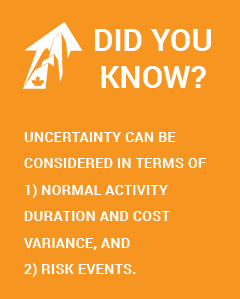

Scheduling practice:
Uncertainty in the project schedule is accounted for and explicitly defined (e.g., addition of time contingencies, additional resource assignment).
Projects are late because that is the way they are planned. Not recognizing and managing uncertainty results in lack of preparedness, poor reaction to events, unnecessary project schedule delays, losses, angry participants and poor morale.
If you are taking a trip to a nearby town on a familiar route, then you probably have a good idea of the typical time this will take, and most times will plan your travel with this in mind. If you have a good drive with light traffic and sunny weather, you might arrive five or ten minutes earlier on a one-hour drive. However, there are many things that can delay you from the typical: road construction, poor weather conditions, other slower moving vehicles, troubles with your vehicle, etc., some of which could significantly increase your travel time.
Too often we plan for the typical in construction, and do not adequately account for the uncertainty that we know is part of the process, and equally important, do not acknowledge that there are generally more things that can go wrong than can go right. In other words, if we run the numbers then we know that the duration will more often be over the typical (or late, if this is the value used for planning).
Uncertainty in a project schedule might be captured with terms such as time-contingency, schedule buffer, or slack time. In smaller projects, uncertainty may be accounted for as a general contingency (e.g., a percentage increase) to account for the nature of the project (e.g., the owner and designer, the geographical location) and applies to the overall schedule.
As the scope and complexity of projects increases, so should the tools and techniques to account for uncertainty. For example, risk registers with quantitative probability and impact estimates can be used to adjust schedules, budget and release contingency funds, manage risk, and estimate impact of the risks.
Next installment: We are only as good as the workers on the job!
Previous installment: Innovation is the application of good ideas from a variety of sources

ABOUT THE PERFORMANCE BENCHMARKING TOOL
The free Performance Benchmarking Self-Assessment Tool is designed to assist construction and maintenance employers in measuring their organization in relation to a specific set of recognized best practices. In addition, you will be able to compare your organization’s efforts against other construction and maintenance employers. From the results of the self-assessment tool you will also be able to identify areas for continuous improvement.
The self-assessment tool is designed to be completed either individually by a member of your management team or in a collaborative setting. Consider bringing your leaders/managers together to work through the tool and take time to discuss the perspectives of each group member.
This initiative is supported by the National Research Council of Canada Industrial Research Assistance Program (NRC IRAP).

Productivity
